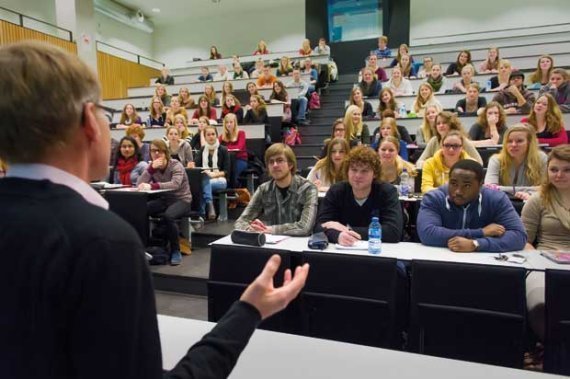This is the advice of the committee that has been studying the consequences of the massive growth in student numbers. In recent years, Wageningen enrollments have gone up by 10 percent, and prognoses for the coming years suggest that the trend will continue.
The Growth Committee lined up the options for the university’s response to these developments, which range from ‘unbridled growth’ to ‘stepping hard on the brakes’. The committee’s own preference was clearly for a middle way: somewhat slowing the growth rate and at the same time bringing in reforms that make the education system more scalable.
The main innovation suggested by the committee is to get fulltime students making more use of e-learning methods. This means, for instance, that lecturers do not have to give as many lectures, and that students learn the material at home from films and assignments. Teachers spend much more of their teaching time on intensive contact. That way the university should be able to retain its unique reputation for small-scale, intensive education. At the same time, the university should try to attract slightly fewer students. Limiting admissions to programmes and targeting recruitment activities more precisely would be two ways of doing this.
In many cases, E-learning is actually a didactic improvement
Rector Martin Kropff
Rector magnificus Martin Kropff is positive about the report. ‘We are very pleased that a detailed growth scenario has been worked out in which the quality of education remains the main priority.’ Kropff denies that the emphasis on e-learning constitutes a deterioration in educational quality: ‘In many cases, this is actually a didactic improvement.’ He also pointes out the e-learning helps with adapting the programme to the needs of fast and slow students. The student council, too, is positive about the future scenario the committee has opted for. ‘Although there are a few potential catches to it, of course’ says student council spokesperson Simone Ritzer. The WUR council will respond to the report in due course.
| Het rapport koos voor voor scenario drie uit vier toekomstvisies:: | 1. Unbridled growth, no change to teaching methods | |
|---|---|---|
| About 16,000 students in 2025; 5000 fte staff, more than 1000 academic staff | ||
| WU builds two new teaching buildings and two more sports halls | ||
| About 5000 more rooms are needed in Wageningen | ||
| 2. Unbridled growth with reformed teaching methods | ||
| About 16,000 students in 2025; 4500 fte staff, 900 academic staff | ||
| WU builds two new teaching blocks and two more sports halls | ||
| About 4000 more rooms are needed in Wageningen | ||
| 3. Slow down growth a bit, and reform teaching methods (recommended) | ||
| About 13,000 students in 2025; 4000 fte staff, 700 academic staff | ||
| One small new teaching building plus rented space, and one new sports hall | ||
| 3000 more rooms needed (temporarily) in Wageningen | ||
| 4. Stepping on the brakes and selecting students on ability | ||
| About 9-10,000 students in 2025, 3600 fte staff, 700 academic staff | ||
| No new buildings apart from some sports facilities | ||
| 1000 more student rooms needed in Wageningen |

